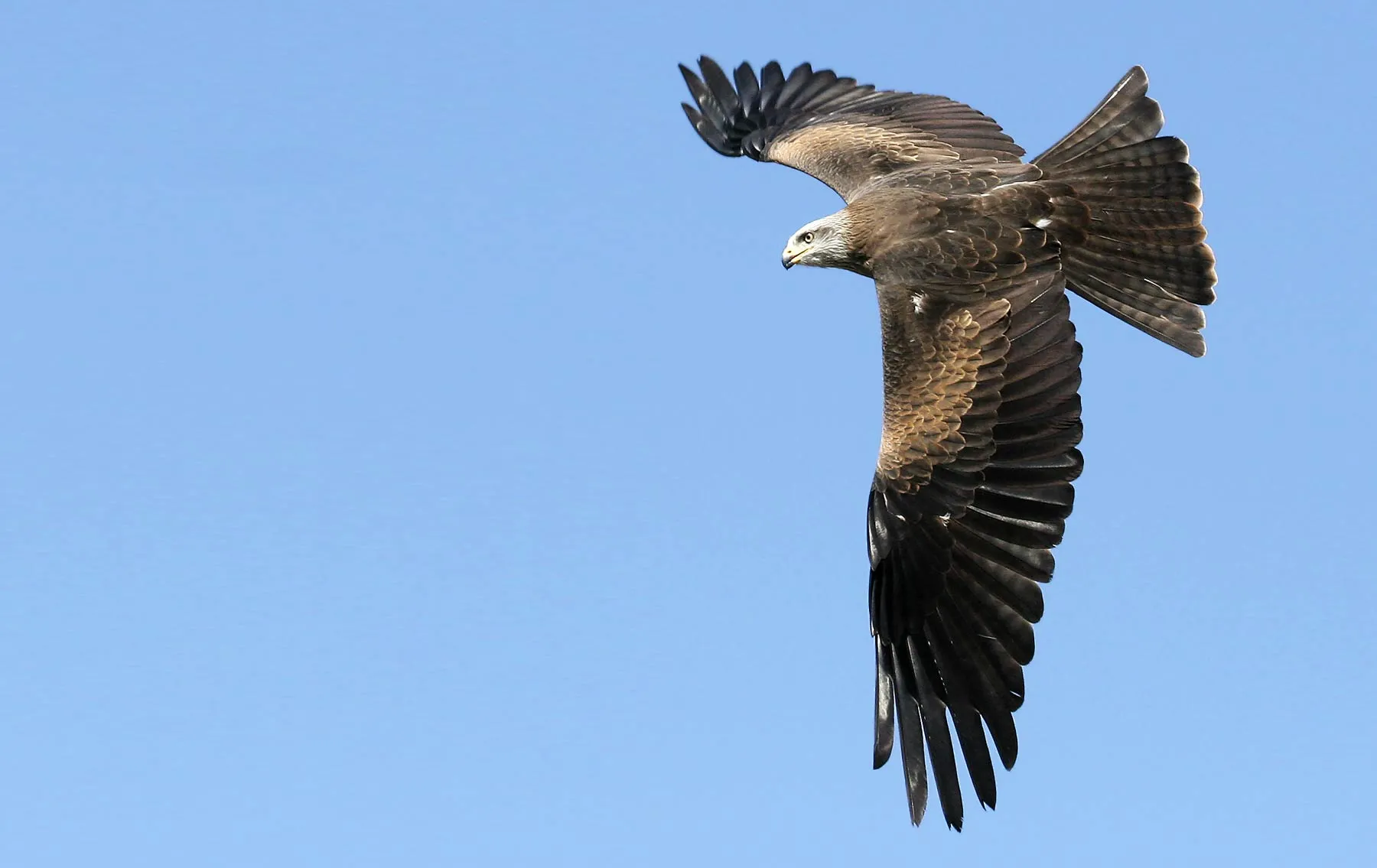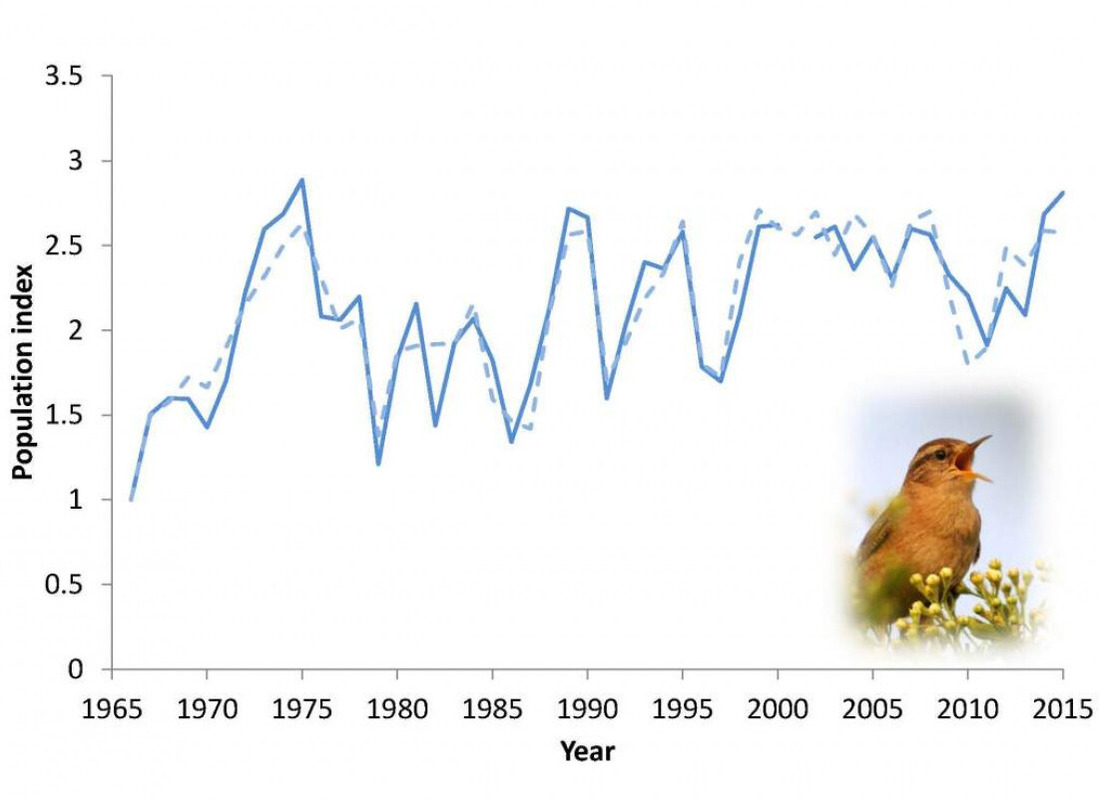Climate change has been widely cited as one of the most significant threats to biodiversity, and its impact is projected to become increasingly severe in the future. It is important to gather evidence to determine how species and populations respond to climate change now. This information can then be used to help improve our understanding of future scenarios, and to inform policies and conservation management strategies to help species adapt.
BTO’s work on climate change covers these three components: Documenting impacts, Projecting the future, Informing adaptation

Documenting impacts
Given its history of long-term biological monitoring, BTO has been in the forefront of research to document the impacts of climate change on UK biodiversity. It was BTO research which first reported how birds are laying their eggs earlier in the year, and BTO data which first demonstrated that animal distributions were shifting northwards in response to climate change. BTO data and research have since contributed significantly to the evidence-base on the impacts of climate change on UK biodiversity, as summarised in a number of review publications (Biodiversity Climate Change Impacts Report Card 2015; 2017 edition of the State of UK Birds, Pearce-Higgins 2017).
Specifically, BTO research has shown that populations of many resident bird species are likely to have increased in response to warmer temperatures, whilst populations of long-distance migrants do not show this same benefit, and may be more susceptible to negative effects of hot, dry summer weather (Pearce-Higgins et al. 2015). The combined effect of these responses has been to change where species are found (Gillings et al. 2015, Massimino et al. 2015) and the assemblage of bird species found at a particular location (Davey et al. 2012), both in the UK and across Europe, where BTO data have also contributed to the evidence for change.
BTO has also helped identify the mechanisms underpinning these changes. One component is phenological change, where the timing of biological events (such as egg laying) alters in response to warming, and the potential of this to disrupt ecological interactions between species (Thackeray et al. 2016). As far as British birds are concerned, BTO analyses suggest that changes in phenology may have a more limited impact on bird populations than initially thought (Franks et al. 2018). Potentially more important are the effects of climate-driven reductions in prey populations, as highlighted by collaborative work on peatland species, which reveals that hot, dry summers reduce the abundance of craneflies that provide important food for breeding birds such as golden plovers (Carroll et al. 2015).
BTO-led analyses of data on taxa other than birds show that climate change may have contributed to large-scale moth declines, whilst warmer temperatures may have increased the abundance of flying aphids (Martay et al. 2017). These trends have potential implications for ecosystem function and may affect populations of insectivorous birds which feed on those groups. Summer drought has the potential to significantly reduce the availability of earthworms to birds, as discovered by a novel citizen science project that engaged 12,000 school children from over 450 schools (Martay & Pearce-Higgins 2018).
Given ongoing uncertainty over the impacts of climate change on global biodiversity, BTO has collaborated with our partners in the Cambridge Conservation Initiative to review the mechanisms linking natural population responses to climate change around the world. This work identified that changes in species interactions, such as reductions in prey populations, were the most important causes underlying species’ responses to climate change (Ockendon et al. 2014). Further, the effect of temperature or precipitation upon species’ populations varied predictably with latitude, and between species groups (Pearce-Higgins et al. 2015). Ecological systems in the tropics are strongly driven by rainfall, whilst those at higher latitudes change in response to temperature. Importantly, both papers identified global response to climate change.

It was BTO research which first reported how birds are laying their eggs earlier in the year.
Projecting the future
The impact of future climate change is likely to be greater than that already experienced. We are working to improve the evidence-base around possible future climate change scenarios, in particular through developing novel approaches to model the impacts of climate change on species abundance.
Our research has identified that the UK’s internationally important wintering waterbird and breeding seabird populations are particularly vulnerable to future climate change (Johnston et al. 2013). We have also used BBS data to predict future breeding bird population trends and thereby assess species’ vulnerability to climate change under different warming scenarios (Massimino et al. 2017). A BTO-led consortium to assess the risks or opportunities of climate change to over 3,000 species across 17 taxonomic groups that occur in England found that bryophytes, vascular plants, and upland habitats, contained the greatest proportion of species at high risk from climate change, although for many taxa there was a high degree of uncertainty in these assessments (Pearce-Higgins et al. 2017). Species-level assessments and associated guidance are being incorporated into updates to the Natural England adaptation manual.
Internationally, BTO has contributed to the development of the IUCN guidelines on climate change vulnerability assessment (Foden et al. 2018). Continued work on the development of appropriate approaches to this assessment undertaken through a PhD at the University of York in collaboration with RSPB, led to an important evaluation of the efficacy of existing methods (Wheatley et al. 2017), and ongoing assessments for European biodiversity.

Informing adaptation
Climate change vulnerability assessment helps conservation organisations to prioritise. The final component - a critical additional part of BTO’s climate change work - is to provide ongoing evidence to inform conservation responses to climate change (adaptation). This has primarily focussed on two areas consistent with the principles of the Lawton Review ‘Making Space for Nature’.
Firstly, large shifts in species’ distributions in response to climate change have led some to question the conservation paradigm associated with the maintenance of static protected areas. BTO was part of a collaborative study led by the University of York, which demonstrated that species from several taxa that were expanding their ranges were three-times more likely to have colonised a region via protected areas than expected by chance. Local extinctions were less likely to have occurred on protected areas, particularly close to the southern edge of where species are found (Gillingham et al. 2015). This could, in part, be a result of management successfully reducing species’ vulnerability to climate change (Pearce-Higgins et al. 2019). BTO-led future modelling of the projected impacts of climate change on birds showed that by protecting an extensive network of large, semi-natural sites important for a wide-range of species, the Special Protection Area network, established under the EU Birds’ Directive, would remain resilient and effective despite future climate change, even if the species found at each site alters (Johnston et al. 2013). This work was quoted directly in the fitness check of Birds and Habitat Directives as evidence to support the continued value of Natura 2000 sites in a changing climate.
Secondly, a much discussed principle of climate change adaptation is that of having increasingly connected landscapes, with networks of semi-natural habitats. BTO-led analyses of woodland Common Birds Census (CBC) data demonstrated that bird populations in sites with a greater amount of woodland in the wider landscape are more likely to recover quickly from cold-winter events, from which we can infer that the greater connectivity in such landscapes facilitates more rapid immigration and colonisation of such sites (Newson et al. 2014). Further, changes in the structure of butterfly and bird communities in response to warming, revealed using a combination of Butterfly Monitoring Scheme (BMS) and CBC data, are related to the extent of semi-natural habitat in the wider landscape (Oliver et al. 2017). This work has direct policy-relevance, for example contributing to the evidence base in support of using agri-environment schemes to increase the extent of semi-natural habitats and reduce fragmentation.
Citizen science monitoring provides the most cost-effective and sustainable solution for large-scale and long-term data collection required to examine the impacts of climate change.
Conclusion
Citizen science monitoring provides the most cost-effective and sustainable solution for large-scale and long-term data collection required to examine the impacts of climate change. BTO data and analyses provide crucial evidence to document the impacts of climate change on UK biodiversity, addressing a clear knowledge gap for policy-makers, and have made an important contribution to the evidence base globally. BTO has led a number of analyses projecting future impacts of climate change across taxa for the UK, providing a good basis on which to identify the most vulnerable species, and has contributed to our knowledge and understanding of climate change adaptation. Whilst ongoing monitoring data will continue to provide a resource to track impacts of climate change, more work is required to understand the ecological mechanisms underpinning these. Addressing the more limited evidence-base around climate change adaptation, and considering how adaptation projects should be monitored and evaluated through time, is a current organisational priority for BTO.
If you also work in this area, and would be interested in discussing a potential collaboration with BTO, please do get in touch: info@bto.org
Staff Contact(s)
James Pearce-Higgins
Director, Science

Blaise Martay
Senior Research Ecologist

Dario Massimino
Senior Data Scientist

Samantha Franks
Senior Research Ecologist

Related Publications
Martay, B., Brewer, M.J., Elston, D.A., Bell, J.R., Harrington, R., Brereton, T.M., Barlow, K.E., Botham, M.S. & Pearce-Higgins, J.W.
2016
Thackeray, S.J., Helaouet, P., Johns, D.G., Jones, I.D., Bacon, P.J., Brereton, T.M., Carvalho, L., Clutton-Brock, T.H., Duck, C., Edwards, M., Elliott, J.M., Hall, S.J.G., Harrington, R., Pearce-Higgins, J.W., Pemberton, J.M., Sparks, T.H., Thompson, P.M., White, I., Winfield, I.J., Henrys, P.A., Hemming, D., Leech, D.I., Bell, J.R., Botham, M.S., Burthe, S., Mackay, E.B., Massimino, D., Høye, T.T., Kruuk, L.E.B., Wanless, S. & Atkinson, S.
2016
Martay, B. & Pearce-Higgins, J.W.
2018
Massimino, D., Johnston, A. & Pearce-Higgins, J.W.
2015
Davey, C.M., Chamberlain, D.E., Newson, S.E., Noble, D.G. & Johnston A.
2012
Ockendon, N., Baker, D.J., Carr, J.A., White, E.C., Almond, R.E.A., Amano, T., Bertram, E., Bradbury, R.B., Bradley, C., Butchart, S.H.M., Doswald, N., Foden, W., Gill, D.J.C., Green, R.E., Sutherland, W.J., Tanner, E.V.J. & Pearce-Higgins, J.W.
2014
Foden, W.B., Young, B.E., Akçakaya. H.R., Garcia, R.A., Hoffmann, A.A., Stein, B.A., Thomas, C.D., Wheatley, C.J., Bickford, D., Carr, J.A., Hole, D.G., Martin, T.G., Pacifici, M., Pearce‐Higgins, J.W., Platts, P.J., Visconti, P., Watson, J.E.M. & Huntley, B.
2018
Pearce-Higgins, J.W., Eglington, S.M., Martay, B. & Chamberlain, D.E.
2015
Johnston, A., Ausden, M., Dodd, A.M., Bradbury, R.B., Chamberlain, D.E., Jiguet, F., Thomas, C.D., Cook, A.S.C.P., Newson, S.E., Ockendon, N., Rehfisch, M.M., Roos, S., Thaxter, C.B., Brown, A., Crick, H.Q.P., Douse, A., McCall, R.A., Pontier, H., Stroud, D.A., Cadiou, B., Crowe, O., Deceuninck, B., Hornman, M. & Pearce-Higgins, J.W.
2013
Pearce-Higgins, J.W., Ockendon, N., Baker, D.J., Carr, J., White, E.C., Almond, R.E.A., Amano, T., Bertram, E., Bradbury, R.B., Bradley, C., Butchart, S.H.M., Doswald, N., Foden, W., Gill, D.J.C., Green, R.E., Sutherland, W.J. & Tanner, E.V.J.
2015